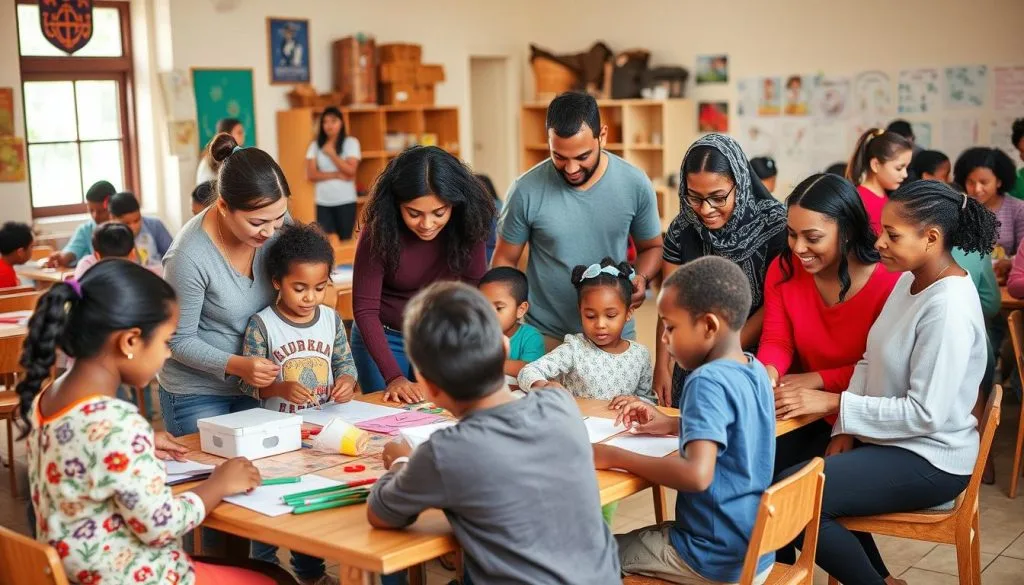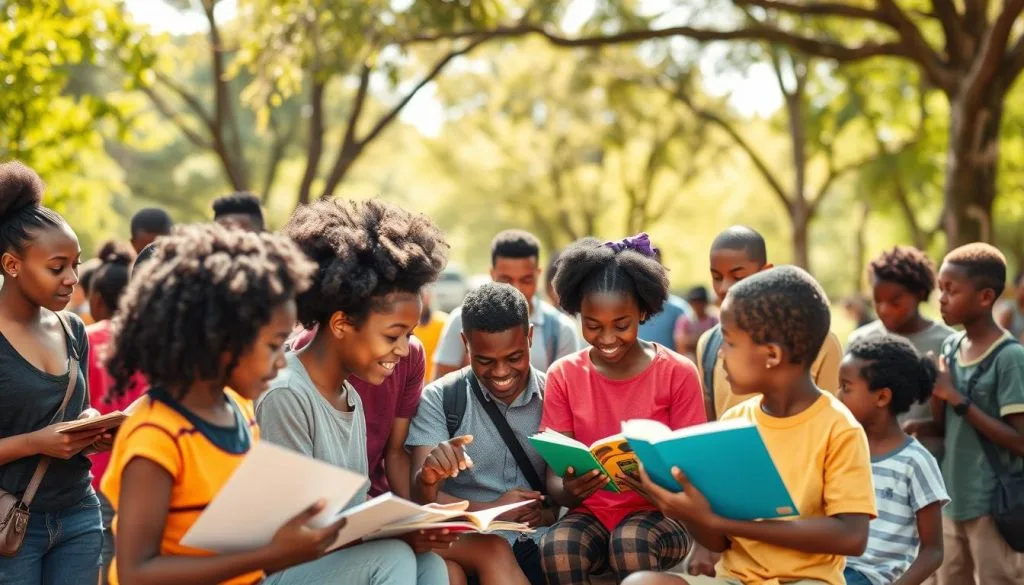In a vibrant city, a community center was a beacon of hope for young people. Jamal, a bright-eyed teenager, walked through its doors, unsure of his future. This moment would change his life forever.
Jamal’s story shows the impact of outreach programs for black youth. These programs help by fostering community, building connections, and nurturing relationships. They break barriers, inspire growth, and unlock potential in every young person.
As we explore impactful outreach, Jamal’s story is a reminder of its power. Join us as we look at strategies, challenges, and triumphs in empowering black youth. We aim to create a more equitable future for all.
Key Takeaways
- Outreach programs offer crucial support and guidance for black youth, addressing disparities and unlocking their potential.
- Effective outreach strategies focus on fostering community, building connections, and nurturing relationships.
- These initiatives inspire personal growth, break barriers, and create a more equitable future.
- Understanding outreach’s importance and successful models can inspire more communities to act.
- Collaboration, funding, and impact assessment are crucial for sustaining impactful outreach programs.
Understanding the Importance of Outreach for Black Youth
It’s vital to tackle the special challenges black youth face in the US. We need to make sure they have a welcoming place to grow. This means setting up mentorship programs and fun activities to boost their confidence.
Key Statistics and Data
Black students in the US often deal with big gaps in education and wealth. For example, only about 79% of black students graduate from high school. This is lower than the national average of 85%. Also, only 22% of black adults have a college degree, compared to 36% of everyone else.
Addressing the Achievement Gap
The gap in achievement between black and white students has big effects. It can limit job chances, earnings, and life quality. Programs aimed at black youth can help. They offer academic help, career advice, and mentorship programs to inspire them.
The Role of Community Involvement
Getting the community involved is key to helping black youth. Working with schools, nonprofits, and businesses can create a strong support network. This teamwork helps make sure inclusive environments and engaging activities are available for all.
“Investing in the future of black youth is not just a moral imperative, but a strategic necessity for the progress and prosperity of our society as a whole.”
Successful Programs: Models of Impactful Outreach
Exploring impactful outreach for Black youth, we find pioneering initiatives making a difference. These programs offer hope, empowering young people. They promote family involvement, faith-based values, and leadership development.
Highlighting Pioneering Initiatives
The Harlem Children’s Zone is a beacon of hope. It offers a community-based approach to youth development. It combines education, social services, and family involvement for a holistic support system.
The 100 Black Men of America mentoring program is another inspiring example. It pairs African American youth with successful mentors. These mentors provide guidance, support, and leadership development opportunities. This program instills faith-based values and helps young people reach their potential.
Elements of Successful Programs
Effective outreach programs share common traits. They include:
- Strong community partnerships and family involvement
- Focus on faith-based values and character development
- A comprehensive approach addressing youth well-being
- Dedicated mentorship programs for leadership development
- Innovative, culturally-relevant curricula and activities
Case Studies: Real-Life Examples
Let’s look at some successful outreach programs through case studies:
- The Concerned Black Men National, Inc. initiative in Washington, D.C. offers academic support, mentorship, and community engagement to empower Black youth.
- The Youth Empowerment Services (YES) program in Los Angeles, California, focuses on leadership development, mental health services, and family involvement.
- The Evanston Scholars program in Evanston, Illinois, provides college preparation, mentorship, and financial assistance to help students achieve their educational goals.
These case studies show the diverse approaches and innovative strategies of successful outreach programs. They make a lasting impact on Black youth’s lives.

Engaging the Community: Building Strong Partnerships
Building a strong community is key for helping black youth. We can create a supportive place for them to grow. This part talks about how to get the community involved and make strong partnerships.
Schools as Community Anchors
Schools are important for the community. They help with youth development. By working with schools, we can reach more people and build strong bonds.
Collaboration with Nonprofits
Nonprofits know the community well. Working with them helps us reach more people. This way, we can give young people the support they need.
Involving Local Businesses
Local businesses can help a lot. They can give money, things, and chances to learn. This helps the community feel involved and helps young people grow.
| Engagement Strategy | Key Benefits |
|---|---|
| Schools as Community Anchors | – Leverage existing infrastructure and resources – Connect with students, families, and the broader community – Foster a sense of belonging and support |
| Collaboration with Nonprofits | – Access to valuable expertise and established networks – Amplify the impact of outreach efforts – Provide comprehensive support for young people |
| Involving Local Businesses | – Secure funding and in-kind donations – Offer job shadowing, internships, and mentorship opportunities – Foster a sense of investment and ownership in the community |
By working together, we can make a big difference for black youth. This teamwork helps us build a strong community. It gives young people the chance to succeed.
https://www.youtube.com/watch?v=fxDLrwPKNV0
Mentorship: A Powerful Tool for Change
Mentorship programs are key in empowering black youth. They create a bond between young people and experienced mentors. This bond opens doors to new possibilities.
It helps in personal growth and prepares the next generation for leadership. They gain skills and confidence to break barriers and make a difference.
Benefits of Mentoring Relationships
Mentorship programs offer many benefits to black youth. They provide a supportive network and guidance. Mentors inspire and encourage, helping young people overcome challenges.
They also serve as role models, pushing mentees to aim high. Through these relationships, young people get access to resources and opportunities. This helps them succeed in school and their careers.
Identifying Effective Mentors
The success of mentorship programs depends on the mentors. Good mentors are compassionate, knowledgeable, and dedicated to their mentees’ growth. They offer empathy, practical advice, and are trusted confidants.
Finding these mentors in the community is essential. They can come from education, business, or civic sectors. This ensures meaningful and lasting mentor-mentee relationships.
Creating Structured Mentorship Programs
- Set clear goals and objectives for the program.
- Recruit and screen mentors carefully to ensure they are dedicated and qualified.
- Train mentors well so they can support and empower their mentees effectively.
- Keep in touch regularly to check on the mentor-mentee relationships.
- Always look for ways to improve and make the program better.
Investing in mentorship programs is crucial. It helps in nurturing relationships and empowering black youth. This approach addresses immediate needs and sets the stage for lasting change.

Role of Technology in Outreach Strategies
In today’s world, technology is key in reaching out to black youth. It helps us use social media and create online resources. These tools help us connect and create a welcoming space for everyone.
Utilizing Social Media for Engagement
Social media is a strong way to connect with black youth and share their stories. Programs like Black Girls Code and The Hidden Genius Project use it well. They share engaging activities and build connections in the community.
Online Resources and Tools
The internet is full of educational resources for black youth. Online, there are many inclusive environment chances, like interactive learning and virtual mentorship. These digital tools help more young people get the education they need.
Virtual Mentorship Opportunities
Virtual mentorship has opened new ways to support black youth. Online, they can meet mentors from different backgrounds. This helps them build connections and get guidance. It makes it easier for more young people to get the support they need.
| Program | Engagement Approach | Key Impact |
|---|---|---|
| Black Girls Code | Leveraging social media to promote engaging activities and connect with the community | Empowering black girls to pursue STEM education and careers, fostering an inclusive environment |
| The Hidden Genius Project | Utilizing online resources and tools to provide engaging activities and virtual mentorship opportunities | Equipping black male youth with the skills and confidence to become technology leaders and entrepreneurs, building connections within the community |
“Technology has the power to transcend boundaries and create meaningful connections. By harnessing its potential, we can unlock new avenues for empowering black youth and driving positive change.”
Empowering Youth Through Education
Education is a powerful tool for empowering black youth and breaking the cycle of inequality. It gives them access to quality programs and resources. This helps build a sense of community, develop leadership skills, and support family involvement in education.
After-School Programs and Tutoring
After-school programs and tutoring are key for black youth’s education. They provide a safe space for students to get help with homework and enjoy enriching activities. These programs help students love learning, improve grades, and form strong bonds with mentors and peers.
Access to STEM Education
It’s vital to increase STEM education access for black youth. This prepares them for future jobs. By offering STEM experiences and connecting them with role models, we spark innovation and close the achievement gap. STEM-focused clubs, coding workshops, and science fairs are especially impactful.
Scholarships and Financial Aid Resources
Financial barriers often stop black students from going to college. Scholarships and financial aid resources can help. Organizations that offer scholarships, college readiness programs, and aid with financial applications make a big difference.
By investing in education, we empower black youth and create a more equitable future. Initiatives that foster community, promote leadership, and involve families are crucial.
| Program | Key Benefits | Impact |
|---|---|---|
| After-School Tutoring | Personalized academic support, Improved grades, Increased engagement | Higher graduation rates, Preparation for college |
| STEM Outreach Initiatives | Hands-on learning, Exposure to STEM careers, Confidence in STEM skills | Increased STEM degree enrollment, Diversification of the STEM workforce |
| Scholarship Programs | Financial assistance, College access, Mentorship and guidance | Higher college enrollment and completion rates, Improved economic outcomes |
Health and Wellness Outreach
Ensuring the well-being of black youth is key in outreach programs. These efforts help beyond just school work. They focus on mental health, physical fitness, and safe spaces for young people to grow.
Addressing Mental Health Needs
Mental health issues hit the black community hard. Outreach programs are working to offer support that fits their culture. Groups like the Black Youth Project 100 provide counseling and wellness workshops. They aim to create an inclusive environment and nurturing relationships.
Nutrition and Physical Activity Programs
Healthy lifestyles are a big part of these outreach efforts. The The Steve Fund runs programs that teach nutrition and cooking. They also have sports and fitness activities. These programs help black youth develop healthy habits for life.
Creating Safe Spaces for Youth
Outreach programs also create safe places for black youth. They can explore, express themselves, and make connections. Community centers and afterschool programs offer inclusive environments, nurturing relationships, and engaging activities. They help young people feel a sense of belonging and grow.
By focusing on the whole person, these programs are making a big difference. They help black youth thrive and set them up for success in the future.
Advocacy and Civic Engagement
Advocacy and civic engagement are key to giving Black youth equal chances. Teaching them about their rights and getting them involved in local government empowers them. This way, they can make a positive change in their communities.
Educating Youth on Their Rights
Groups like the NAACP Youth & College Division and the Youth Activism Project are leading the way. They teach Black youth about their civil rights and legal protections. Through workshops and community outreach, they make sure young people know their power to fight for justice.
Encouraging Participation in Local Government
It’s important to get Black youth involved in local decision-making. Programs that foster leadership development and offer volunteer opportunities help. They connect young people with city councils and school boards, giving them a voice.
Amplifying Youth Voice in Decision-Making
We must make sure Black youth are heard in policy discussions and community planning. By giving them a platform, we ensure their unique perspectives are considered. This way, their needs are met in decision-making.
| Organization | Focus | Impact |
|---|---|---|
| NAACP Youth & College Division | Educating youth on civil rights, advocacy, and civic engagement | Empowered over 10,000 young leaders to become active in their communities |
| Youth Activism Project | Providing resources and training for youth-led advocacy and community organizing | Supported the creation of over 100 youth-led initiatives addressing local issues |
“When young people are empowered to raise their voices and take action, they have the power to transform their communities and create a more just and equitable society.”
Funding Challenges and Solutions
Getting the money needed is a big challenge for programs helping black youth. These programs often face tough times getting the funds they need. But, by looking for different funding sources and using smart financial plans, they can keep going strong.
Identifying Sources of Funding
Programs can look for money from government grants, private foundations, and companies. Working with local businesses and leaders can also bring in sponsorships and donations. Plus, getting families and volunteers involved helps the program stay strong financially.
Grant Writing Tips for Outreach Programs
Writing a good grant proposal is key to getting the money needed. Good grant writers explain how the program will help, know the community’s needs well, and have a clear plan for the money. They also pay attention to details, tell stories well, and match the grant-maker’s goals.
Building Sustainable Financial Models
Programs need to find new ways to make money to last long. This could mean charging for services, hosting events, or using online platforms for donations. By trying different ways to fund themselves, programs can stay strong and keep helping the community.
| Funding Source | Advantages | Challenges |
|---|---|---|
| Government Grants | Stable, long-term funding | Highly competitive, complex application process |
| Private Foundations | Flexible, tailored to specific needs | Limited funding, narrow focus areas |
| Corporate Sponsorships | Opportunity for partnerships, visibility | Stringent requirements, potential conflicts of interest |
| Community Donations | Builds local support, engages stakeholders | Unpredictable, requires ongoing fundraising efforts |
By looking at different funding options, writing strong grant proposals, and creating lasting financial plans, programs for black youth can get the money they need. This way, they can keep doing important work in their communities.
Measuring Success: Impact Assessment Strategies
It’s key to measure the real impact of outreach programs for black youth. This ensures they keep improving and succeed in the long run. By using strong impact assessment strategies, groups can learn a lot about their work. They can then make better choices based on the data.
Metrics for Evaluating Outreach Programs
Keeping an eye on important signs, like how well participants engage and grow, is vital. Things like how often they show up, their grades, and if they change for the better show the program’s success. These signs help us see the real results of the outreach efforts.
Gathering Feedback from Participants
It’s important to listen to what the youth say about the program. Surveys, group talks, and personal chats can help get their honest thoughts. This way, organizers can know what works well and what needs work, making the program better for everyone.
Continuous Improvement and Adaptation
Looking at the data and what the youth say helps groups find ways to get better. They can make changes to make the program more fun, welcoming, and supportive. This ongoing effort keeps the programs fresh, effective, and meaningful for black youth.
